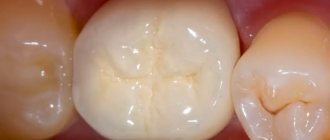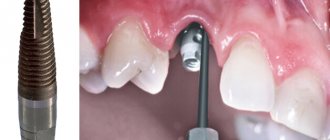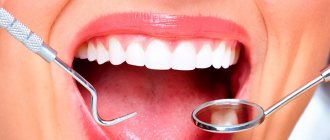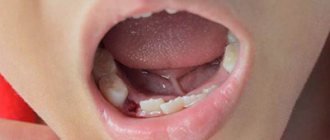You need to think about subsequent prosthetics even before tooth extraction. The first thing you should do is ask which specialist will perform the extraction. It is better to entrust this manipulation to an experienced dental surgeon, who will remove the tooth in a way that is minimally traumatic to the bone tissue. The next important question concerns timing. To find out exactly when a prosthesis can be installed after tooth extraction, you need to contact your dentist. The answer depends on how the lost unit will be replaced, as well as on the characteristics of the clinical picture.
What can be put in place of an extracted tooth?
There are many options for replacing an extracted tooth. An experienced orthopedic surgeon will offer removable and fixed structures, solutions for restoring individual teeth or a number of missing units, and reconstruction of a completely edentulous jaw. For each case, protocols, methods, and treatment techniques are provided.
How to insert a tooth in place of a removed one - options:
- prosthetics on dental implants;
- bridge prosthesis;
- removable prosthetics;
- clasp prosthesis.
What can be put in place of an extracted tooth depends on:
- number of units removed;
- condition of bone tissue;
- dental diagnoses;
- patient's age.
Based on the preliminary diagnosis, the doctor makes a decision on the timing and features of treatment.
Contraindications
No matter how harmless the process of implanting an artificial structure into the jaw may seem, it has a number of important contraindications. This:
- pathological processes in bone tissue;
- jaw bone atrophy;
- weakened immune system;
- diabetes;
- periodontal disease and other destructive pathologies in the gums;
- a deep hole in the place of the removed organ of the oral cavity;
- oncological diseases;
- asthma, allergies to medications;
- HIV;
- carious dental damage;
- pregnancy and lactation.
If you have diseases of internal organs or any other pathologies, you should definitely tell your dentist about them, otherwise the consequences may be unpredictable.
How long does it take for gums to heal after tooth extraction for dental prosthetics?
How many days after extraction you can insert teeth determines the speed of healing of the hole. The process is individual for everyone and depends on many factors:
- type of removed unit - incisor, canine, molar, premolar;
- complexity of the operation - simple extraction or removal with dissection of the gums and sawing of the crown;
- features of the root system - compact, even roots or sinuous, strongly curved, occupying a large area;
- The doctor’s professionalism and experience determines the size of the extracted tooth socket and the likelihood of complications.
How long after tooth extraction can you get dentures?
How long after tooth extraction you can get dentures depends on the speed of tissue healing. Average indicators of restoration of gums and bone structures:
- the first 2 hours after removal - the hole fills with blood, a blood clot forms;
- a week after surgery - the wound heals, new gum tissue forms;
- after 4-6 months, the bone tissue is restored, completely filling the space of the socket.
For removable and fixed dentures, crowns on implants and bridges, different treatment periods are provided:
- removable dentures - in 3-7 days, how will it be possible to make an impression for the manufacture of a prosthetic structure;
- bridges - in a month or two, after complete healing of the tissues;
- prosthesis on implants - depending on the protocol, immediately or after a few months.
If the patient immediately plans to insert a tooth in place of the extracted one, it is better to make an appointment with an implant surgeon. The doctor will prepare directions for mandatory examinations, conduct careful removal, and offer optimal options for restoring the dentition.
Prerequisites
One-time implantation for a patient is a very tempting offer that can kill several birds with one stone: remove the tooth and insert an implant. However, this is possible if the conditions are ideal for the procedure. Otherwise, the implant may not take root properly, causing inflammation and other problems. A one-stage implant will be installed if the patient:
- there are no inflammatory processes of any nature;
- after removal, the gum tissue fits tightly to the bone;
- healthy oral cavity, without caries, periodontal disease, etc.;
- sufficiently healthy jaw bone;
- normal general condition.
If all components are present, implantation will be performed. But if at least one of these conditions is not met, the implant may not grow into the gum properly, and further medical intervention will be required.
Bridge prosthesis in place of an extracted tooth
The design of a dental bridge consists of the main crowns for replacing missing units and two additional ones for fixing the prosthesis on the jaw. During the treatment process, the doctor grinds down the living teeth and attaches crown caps to them. Advantages of a dental bridge for the patient:
- durable permanent installation;
- affordable price;
- aesthetics.
Flaws:
- Delayed prosthetics. The minimum period when a bridge can be installed after tooth extraction is a month after the operation.
- Grinding healthy units. Physical damage to the integrity of the enamel and partially crowns.
- Excessive load on supporting teeth. And degradation of bone tissue under the overhanging part of the denture.
- Gradual loss of aesthetics and functionality. Due to tissue subsidence, a gap is formed between the denture and the gum, visible when speaking. Also, food particles get into the empty space, which often causes inflammation.
- Fragility. The prosthesis and supporting teeth are usually removed 5-7 years after installation.
Doctors explain not only how long after tooth extraction a bridge can be installed, but also why. 4-8 weeks is a reasonable interval, since the tissue at the site of the lost tooth should be completely restored. Otherwise, there is a risk of changing the shape of the gums under the installed prosthesis, and the likelihood of tissue injury at the time of prosthetics increases.
Reasons for installing a crown without removing the nerve
To preserve the tooth, dentists try to maintain blood supply and innervation. After removing the nerve, the enamel is quickly destroyed, exposed to external influences, and caries appears. Whenever possible, the tooth is left alive.
Cases of crown installation without pulp removal:
- destructive gum diseases that lead to loose teeth;
- grinding of teeth located next to problem ones for further installation of crowns, bridges, clasp dentures;
- partial destruction of the crown as a result of mechanical trauma;
- installation of veneers for aesthetic purposes;
- the tooth has changed color and is very different from the others;
- destruction is less than 50%.
Please note: Sometimes patients complain that after installing a crown on a living tooth, pain and swelling of the gums remain. These symptoms are not directly related to the procedure. The main causes of negative consequences are the abnormal location of the channels. Violations of the preparation technique are observed less frequently.
Removable prosthetics
A removable denture is recommended when several units are removed or when the entire jaw is missing. For a single replacement, doctors recommend a temporary option - an immediate prosthesis, which is placed in place of the removed incisor or canine to preserve aesthetics. Then the product is replaced with a permanent and more convenient to wear option.
For removable prosthetics of one tooth, a high-quality impression of the jaw is required, which is made 3-4 days after the extraction operation. To make extended structures for several teeth, doctors recommend waiting until the tissue is completely restored. It takes about 30 days for the gums to heal before prosthetics.
Prices for services
Consultation with a dentist - orthopedist Free Stump tab from RUB 3,900. up to 9500 rub. Ceramic inlay from 8200 rub. up to 17,500 rubles. Metal-ceramic crown CoCr from 7,200 rubles. up to 10,000 rubles. Metal-free ceramics 25,000 rubles. Ceramic veneers from 17,000 rubles. up to 30,000 rubles. Removable prosthesis 9,500 rubles. up to 18,000 rubles Clasp clasp prosthesis from 25,000 rubles up to 28,000 rubles Clasp monomer-free prosthesis 36,000 rubles Nylon prosthesis 15,000 rubles up to 34,000 rubles; metal ceramics for implants from 20,000 rubles. up to 25,000 rub.Crown instead of an extracted tooth - implantation
Implantation is a modern solution for partial and complete adentia. This is what doctors recommend to patients, and there are many reasons for this:
- complete replacement of a lost tooth - not only the upper part, but also the root system;
- restoration of chewing and other functions - after prosthetics, the patient is not limited in the choice of menu, and the quality of speech does not suffer;
- aesthetics - both the crown itself and the artificial gum contour, if present, look natural;
- preservation of bone tissue - bones experience full load, which eliminates atrophy and degradation of bone structures;
- speed of prosthetics - some protocols allow you to restore a tooth immediately after removal.
Implantation options:
- Classic two-step protocol. After removal, the doctor waits for complete healing of the gums and restoration of soft and bone tissues. Then he installs the implant and, after its complete engraftment (4-6 months), places an artificial crown or bridge on the implants without damaging neighboring units. The treatment is long and is recommended for patients who, immediately after extraction, were unable to replace their teeth with prosthetics - the socket has healed, and the tissues have partially atrophied. It is possible to speed up treatment using a two-stage protocol. Premium dental implants Nobel, Strauman take root in 2-4 months, which reduces the period of prosthetics by half.
- One-stage implantation protocol. When a tooth is removed, the patient is immediately implanted with an implant, a gum former or a full-fledged temporary crown. Such treatment requires removal by an experienced implant surgeon, as well as preliminary examination to reduce risks.
- One-stage implantation protocol. It completely eliminates the question of when a tooth can be replaced with a prosthetic after extraction, as it combines all three stages of treatment. The doctor performs an extraction, places a dental implant and immediately loads it with a crown. The patient simply replaces the damaged tooth with a new artificial one, which significantly speeds up the recovery process.
Indications for pulp removal
An informed decision about pulp removal is the last step before installing a crown. Specialists rely heavily on dental experience. The patient’s reputation and health come first, so no one will install an expensive crown and then remove it later.
In what cases is the decision to remove a nerve made?
- advanced caries;
- pulpitis;
- partial exposure of the nerve when grinding the enamel;
- tooth injury resulting in nerve damage;
- hypersensitivity;
- anatomically incorrect tooth structure;
- low landing of the crown.
In the vast majority of cases, depulpation can be avoided if the dentist is fluent in preparation techniques. Prosthetics on living teeth is preferable.
Total prosthetics after tooth extraction
The situation is considered separately - the removal of all teeth immediately before prosthetics. In this case, the patient is faced with complete adentia, which requires emergency treatment.
Option two:
- Removable prosthetics - quickly, inexpensively, with guaranteed atrophy of bone tissue subsequently, frequent replacement of the prosthesis and inconvenience of wearing the product.
- Implantation with installation of a fixed prosthesis - according to all-on-4 or all-on-6 protocols. The essence of the treatment is the installation of a fixed number of dental implants and the attachment of a full denture prosthesis to them. Implantation of 4 or 6 artificial roots is performed on the day of removal. An impression is immediately made, from which artificial teeth are made in a dental laboratory. The longest waiting period is 3 days, after which the patient receives a full-fledged jaw capable of withstanding all physiological loads.
Is it necessary to insert a tooth after extraction?
Many patients do not even ask questions about how many days after tooth extraction they can get a crown or dentures. But in vain. Even a short-term absence of a tooth in the jaw row is fraught with serious consequences:
- displacement of adjacent units and teeth of the opposite jaw towards the empty space;
- jaw deformation, malocclusion;
- improper redistribution of chewing loads, gastrointestinal problems;
- deterioration of diction, the appearance of complexes due to aesthetics and speech.
The longer the interval between removal and prosthetics, the more serious the orthodontic defects and the more expensive the treatment.
What to do with a knocked out tooth?
A “lost piece” that has fallen into snow, mud or autumn slush can only be rinsed with water, but cannot be scraped and cleaned “to a mirror shine” so as not to damage the still living fibers. For the same reasons, you should pick up the tooth by the crown, and not by the root, which will be re-engrafted into the hole. Disinfection of living tissue with alcohol or hydrogen peroxide is also prohibited.
After dislocation, the tooth should be kept in a moist environment, which will significantly increase its chances of replantation and healing. How to achieve this?
- The best natural medium that supports the vitality of a lost tooth is saliva. Therefore, the tooth can be placed in the mouth, on the opposite side from the damaged side, tucked between the cheek and gum. When a baby tooth is dislocated, a child may scream and cry. To prevent the tooth from being swallowed, its transportation can be handled by an accompanying relative—preferably the mother.
- Perhaps the adult victim or those around him have a container for storing contact lenses. The tooth can be placed in the saline solution it contains.
- A small container filled with water or milk will also work.
- If there is a pharmacy in the neighborhood, you can buy any drug that represents a physiological environment - glucose, 0.02 percent furatsilin, novocaine, etc.











